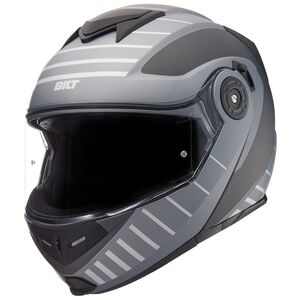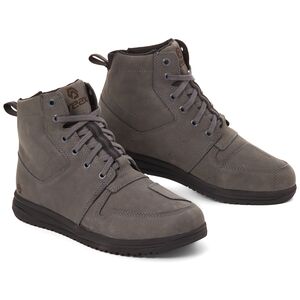If you’re the sort of rider who’s had a few speeding or reckless riding tickets, the FTR is not the motorcycle for you. Unless you want more.
Indian’s liquid-cooled brawler has to be the best hooligan bike currently built in the U.S. of A, and if you aren’t willing to engage in some hooliganism, go buy something else. This motorcycle is at its best when hustled hard, and at its worst when asked to behave. It is, in a word, a handful.
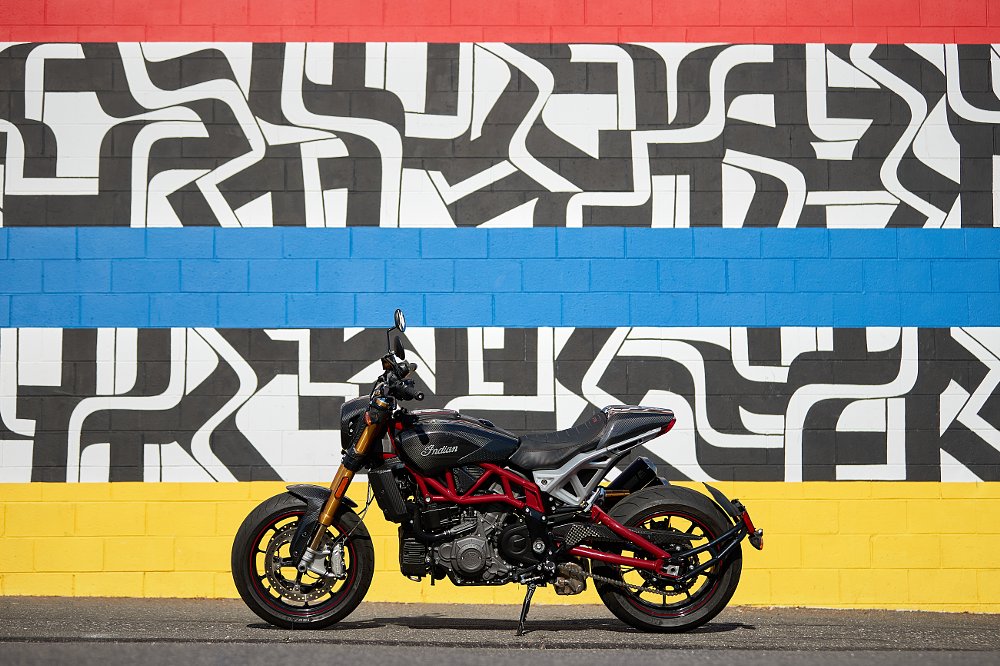
Riders in the United States haven’t seen a domestic sport standard since… well, since the some of the late Buells and arguably the Harley-Davidson XR1200. Sad. Once upon a time, U.S. manufacturers, designers, and engineers built some of the most advanced motorcycles in the world. Both Indian and Harley-Davidson have tried building motorcycles outside the usual cruiser lines over the last few years, and I hope we see more of that.
Indian let me test an FTR in R Carbon trim, the highest spec available. The FTRs are now in their second generation, and the most notable change over the first gen is the change in wheel sizes. Instead of taller wheels with flat track tires, all FTRs now roll on 17-inch wheels with sport rubber. Is this the best FTR ever, or did Indian stray too far from the flat track inspiration that made the FTR unique in the first place?
What is the FTR, exactly?
When I first picked up this motorcycle a few weeks ago, I stopped by a friend’s shop to see what he thought about it. He looked the bike over and asked, “Who’s it for?” Good question. It’s not a cruiser, that’s for sure. It’s too heavy to compare against metric sport nakeds, too potent to be Indian’s entry-level machine, and too road-biased to go anywhere near flat track clay. The price ($16,999 base for the R Carbon) and the performance tell me that this is for an experienced, premium customer, but this buyer isn’t obsessing over spec sheets.
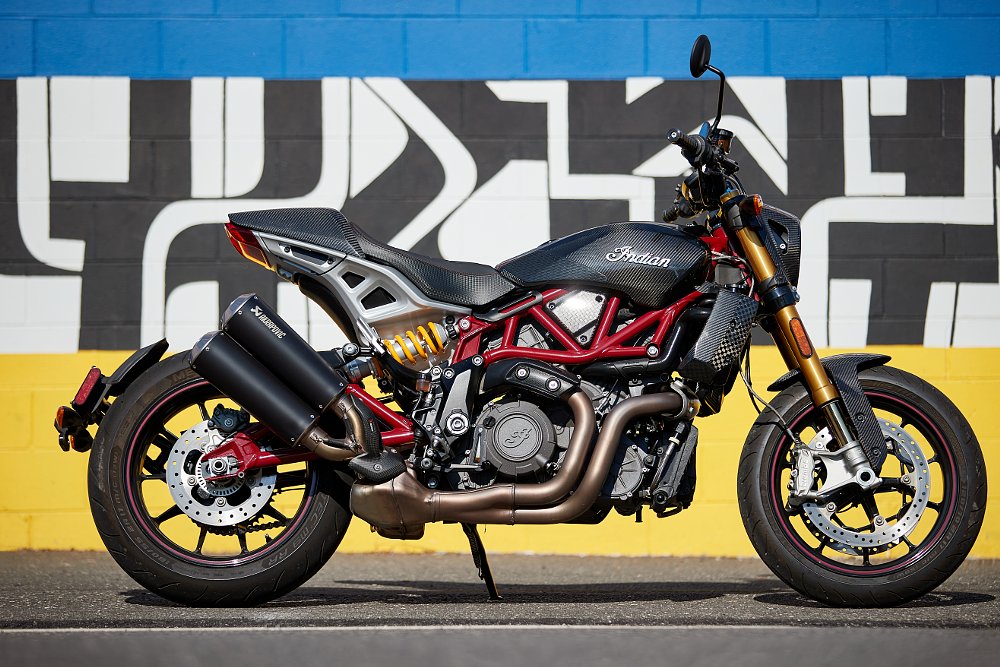
An FTR buyer is probably drawn to the bike for its rip-snorting engine, its unmistakable style, and the fact that it is built in the United States. So what if it’s 50 pounds heavier than a KTM Super Duke? Finally, the thin seat and somewhat aggressive riding triangle tell me this customer is on the younger side of Indian’s customer base. Look to larger Indian models if you like deep, plush saddles.
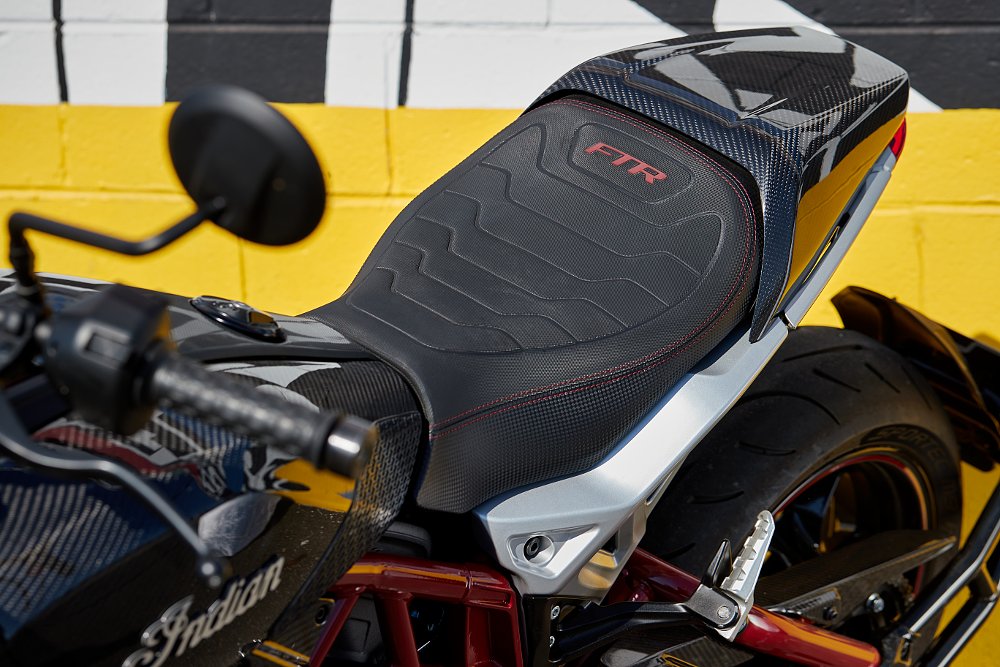
If I had to classify this motorcycle, I think “American sport standard” is probably the best description of the second-generation FTR. American, because it’s an overweight V-twin with flat-track styling cues, and it’s built in Spirit Lake, Iowa. Sport, because it’s properly fast now. And standard, because that’s exactly what Indian calls it.
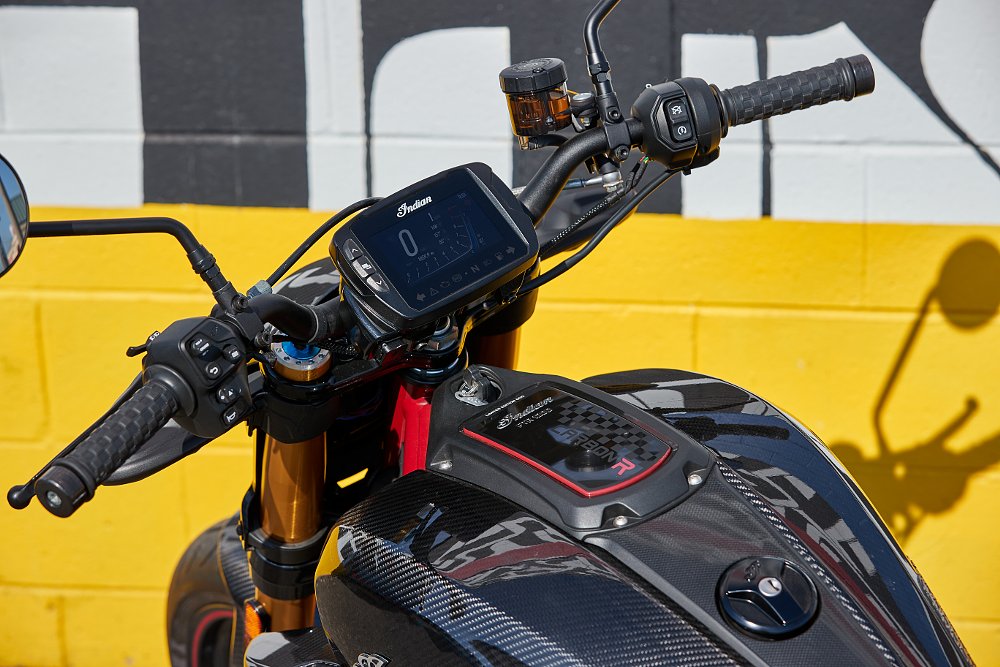
The new FTRs are effectively the same bikes as the initial models aside from a few key changes. I already mentioned the sport wheel sizes, so what else is new? There's a fresh ECU tune that improves cold starting and throttle response, the handlebar is a tad narrower, and the suspension lost a little over an inch of travel in exchange for full adjustability on all models. Indian made these changes in hopes of honing the FTR into a sharper, if slightly more conventional, package. The outlier FTR model is the Rally, which is like a base FTR with taller spoked wheels, a brown seat, and some bolt-on accessories.
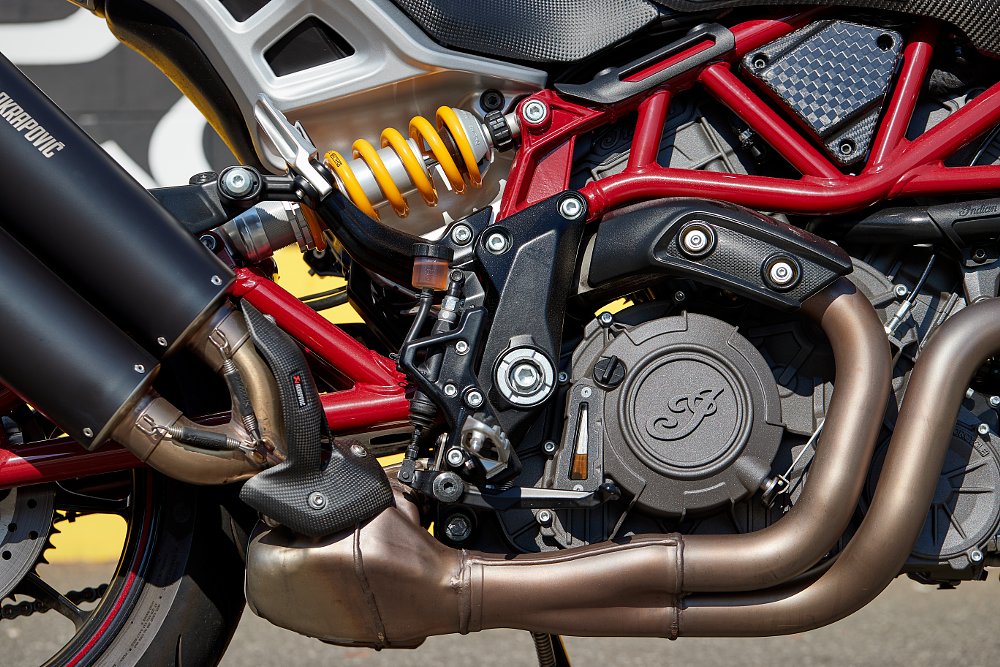
Maybe it’s just me, but I see a Yankee interpretation of a 2014 to 2021 Ducati Monster 1200: open-class V-twin power, trellis frame, stacked exhaust pipes, sporty running gear, a round headlight, and seating for one and a half.
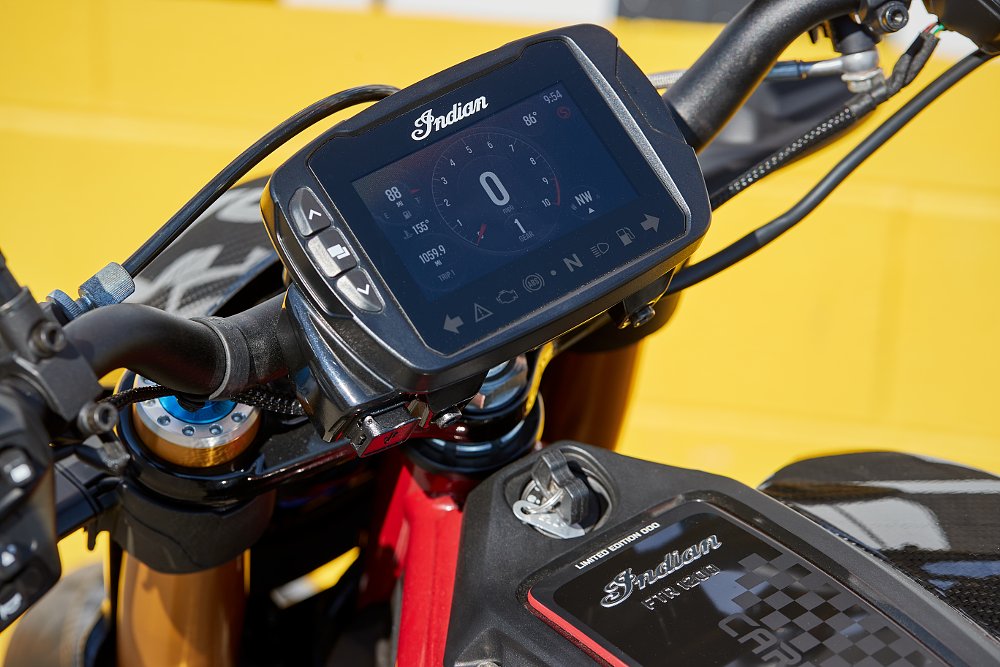
Much of the FTR’s personality comes from its power delivery. Under 4,000 rpm, the bike is pleasantly docile and easy to handle. Pass 4,500 rpm, and the linear throttle feel becomes an Evel Knievel ramp to 8,500 rpm where the fully modern twin’s giving all she’s got. Redline comes shortly after that at 9,000 rpm. The FTR wants to play in the upper end of its powerband, and if you’re the kind of rider who likes listening to the devil on your shoulder, then you owe this motorcycle a test ride.
Electronic guardian angels like wheelie control, lean-sensitive traction control, and rear lift mitigation are included if you need them. Pushing the FTR means you’ll need space, though. Long, sweeping state roads are ideal. Tight, technical hills are a hoot, as well, even though the wheelbase is longish at 60 inches. On slow roads or areas with lots of traffic, the FTR gives the impression that everyone is in your way.
On hot days, the FTR generates almost as much heat as its air-cooled brothers. Indian does include the usual rear cylinder deactivation, and it helps a little. There’s just no avoiding the fact that the FTR’s rear cylinder head is practically poking up through the seat to heat your nethers. Those of you who have owned big V-twins in the past will be fine. Anyone coming from a small or middleweight water-cooled bike might be surprised at how much heat is produced by the engine.
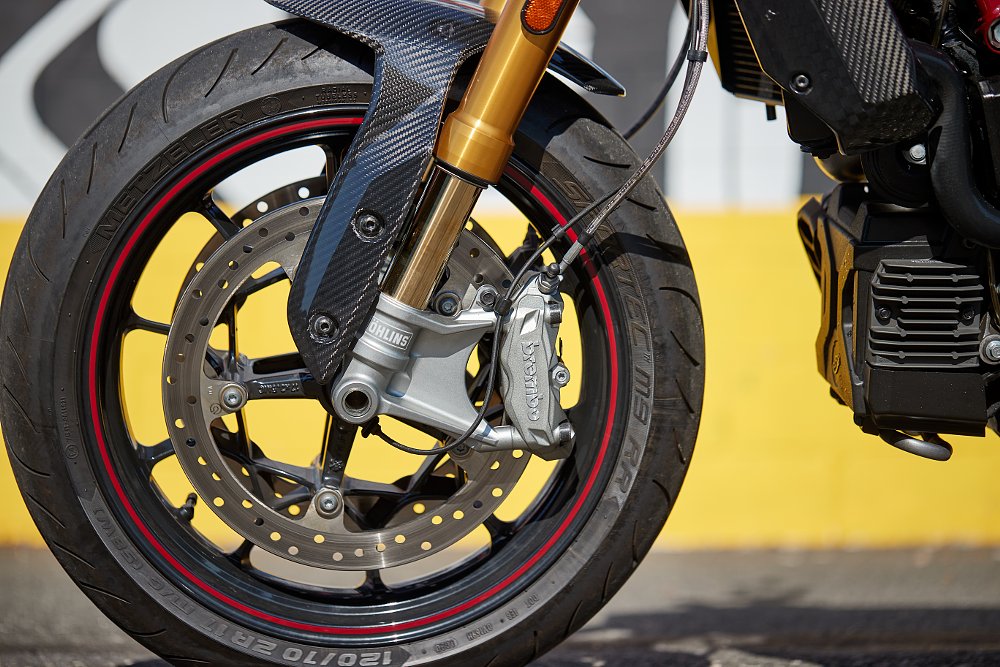
As Zack pointed out in his Daily Rider review of the FTR, this U.S-built bike wears lots of European parts, and that’s probably because of the intended customer for this motorcycle. We’ve got full Öhlins suspension, hunky Brembo brakes, German sport tires, and a tastefully throaty exhaust from Akrapovič in Slovenia. It’s like an Indian Scout went backpacking in Europe for a couple years after high school to find itself. And as Spurgeon mentioned in his review of the original FTR, Indian’s history isn’t just a long line of cushy cruisers. The brand’s early days included motorcycles that were sporty and innovative, and the FTR comes closest to that spirit today.
This isn’t the first time an Indian FTR has appeared on the pages of Common Tread, and the powertrain’s specs haven’t really changed since we first saw this mill back in 2019. It’s still a 60-degree, 1,203 cc V-twin with dual overhead cams and a claimed 120 horsepower at 8,250 rpm. (That’s a 73-cube motor in ‘Murica units.) The peak torque output of 85 foot-pounds hits at six grand. Give the oversquare engine a fistful of revs, and it makes blisteringly short work of accelerating the FTR’s claimed wet weight of 513 pounds. You get a slip/assist clutch to ease gear transitions, and it worked so well that my notes just say “nice!”
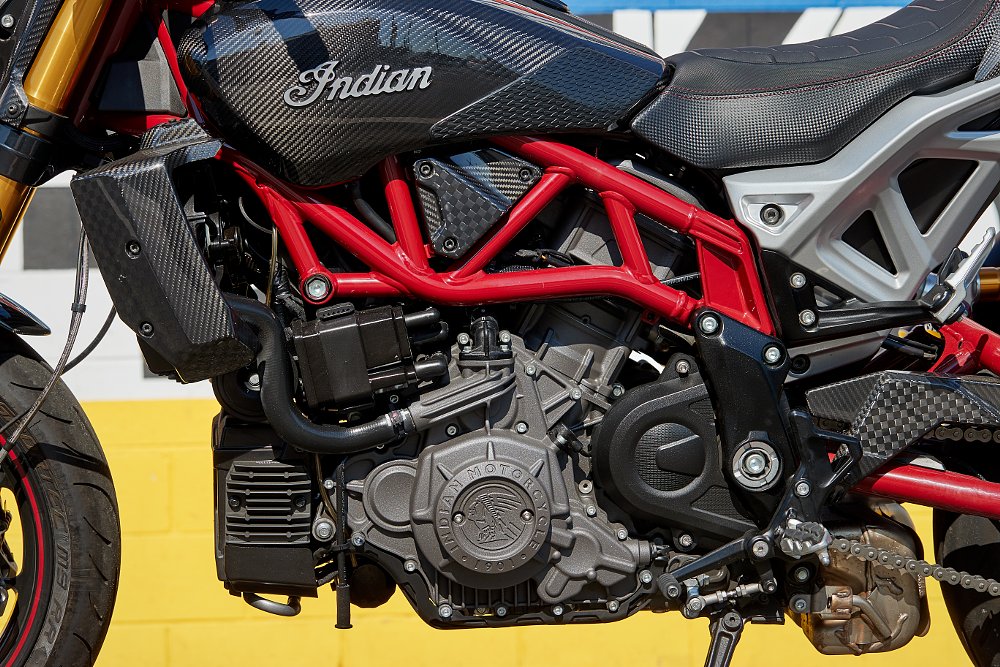
Gone are the DT3-R tires that Dunlop designed for the previous FTRs and looked like they fell off an American Flat Track team hauler. Instead, Metzeler’s superb Sportec M9 RR tires come standard. (Has there ever been such a radical change in stock tires between generations of the same motorcycle?) Indian positions the FTR as a premium motorcycle, and those spiffy tires should be appreciated all the way to the cords. They don’t last terribly long, though, so I’d look at a sport-touring tire if you have to travel a decent distance to reach your favorite roads.
Of course, the FTR R Carbon is named for its exquisite carbon fiber bodywork. Each panel has visual depth and perfectly aligned carbon weave. Subtle from a distance, but flashy and even racy up close, it’s hard not to admire Indian’s work here. These panels got me wondering: How much weight does the R Carbon save over the other models? Indian’s spec sheets tell me that the carbon fiber bodywork saves one pound over the base FTR’s 514 pounds (claimed, wet). That base model starts at $12,999. So if weight savings aren’t a benefit of the R Carbon trim, what’s the $4,000 difference getting you besides trick bodywork?
The lowest trim FTR comes with an analog speedometer, while the S and R Carbon models get Indian’s touchscreen RideCommand system. This was a pretty neat feature when it came out, but these days, it’s only meeting customer expectations as motorcycles gain more onboard tech every year. If you’re looking at getting an FTR with Ride Command, take your favorite gloves with you to the dealership. Some of my riding gloves worked with the screen, but others did not.
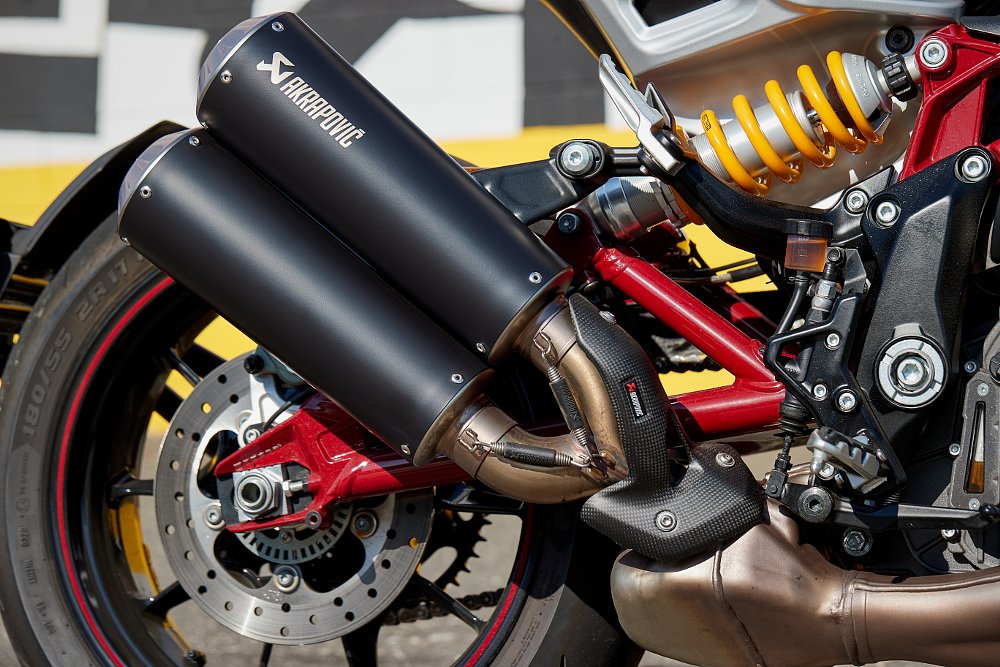
The S and R Carbon models get the Akrapovič mufflers, which are very tame for “aftermarket” pipes. The FTR is nearly stealthy at low rpm. Open it up, though, and the engine barks, rasps, and sizzles up and down the tach. I know somebody somewhere will always want it louder, but I would leave it exactly the way it is. Including this exhaust on upper trim levels tells me that Indian’s looking at younger performance-oriented customers for this bike. Some of them may even be able to pronounce Akrapovič without thinking about it.
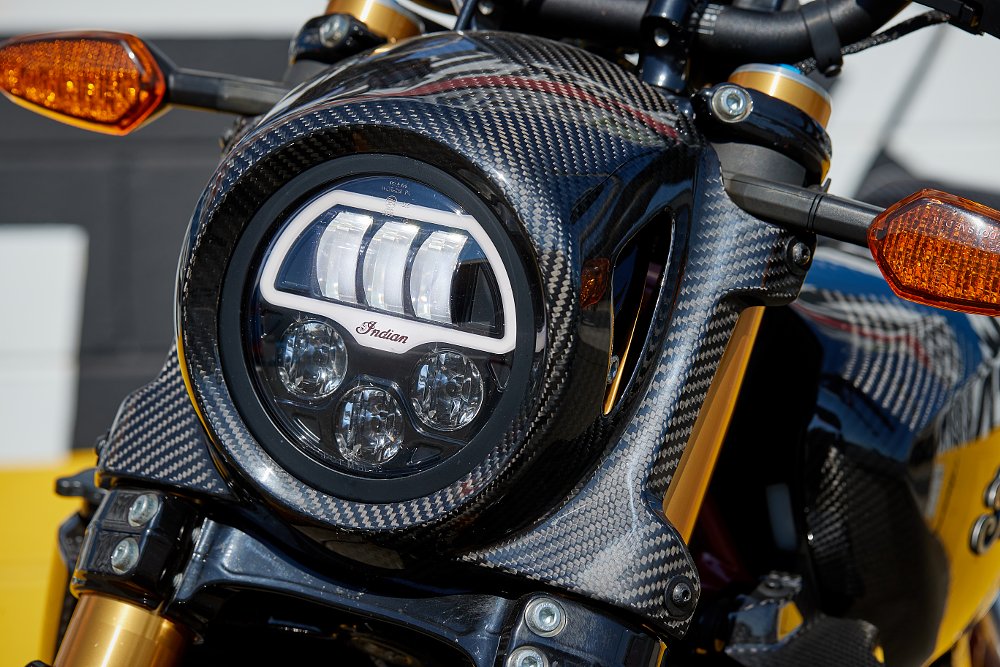
There are a few more upgrades included like a different seat, a paint-matched subframe, and some really neat red wheel stripes that remind me of the redline tires on old muscle cars (or old Hot Wheels versions of old muscle cars). The remainder of that $4,000 difference, however, goes to suspension.
The R Carbon has fully adjustable Öhlins boingers at both ends, and that gives R Carbon owners the best chance at fully harnessing the FTR’s power and newly added sport wheel sizes. I’ll go one step further and say that this is the most competent FTR ever built. The first-gen model never had a prayer of being genuinely competitive on a flat track. At least the R Carbon has a fighting chance at a local track day, and I think it‘d feel a lot steadier on its feet, too. Food for thought: Many riders don't need the Öhlins hotness, so if that sounds like you, the $12,999 base FTR might be a bargain, if you don’t mind the lone color choice and analog gauge.
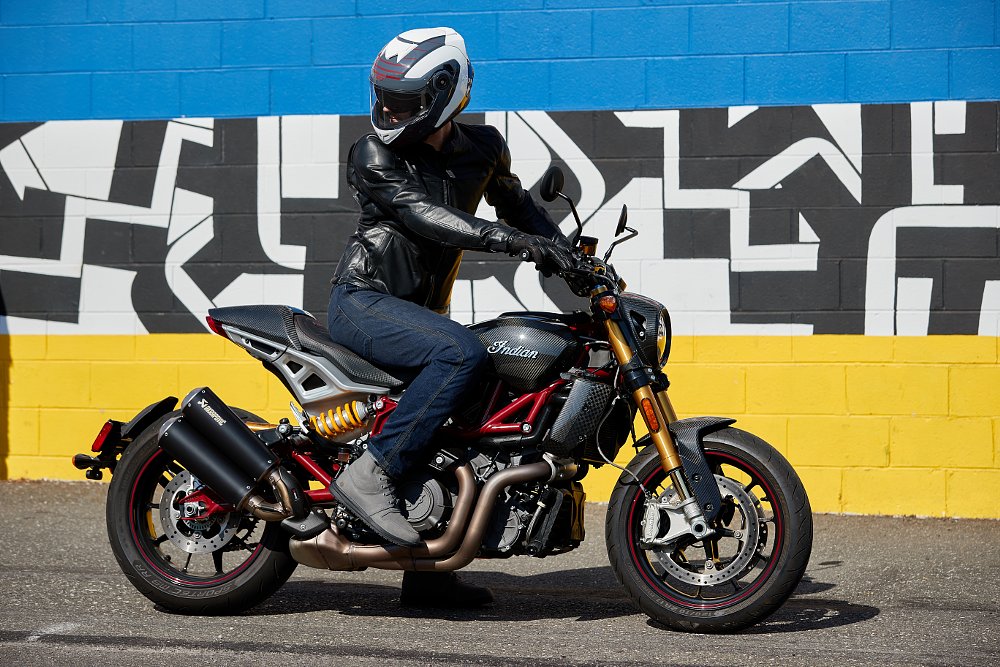
Riding the FTR R Carbon
Over the last few weeks, I’ve ridden the FTR around my usual test roads to see how it stacks up against the previous model. I’ve also tried highways, a little scenic touring, and even some dirt, just for reference.
Starting the FTR is drama-free. My notes here say that the startup animation takes way too long to finish (an industry-wide problem), and the cold-blooded issue from our 2019 review is still present. The weather here in southeastern Pennsylvania has been warmer than usual lately, so I can’t comment on how that might change in cooler months.
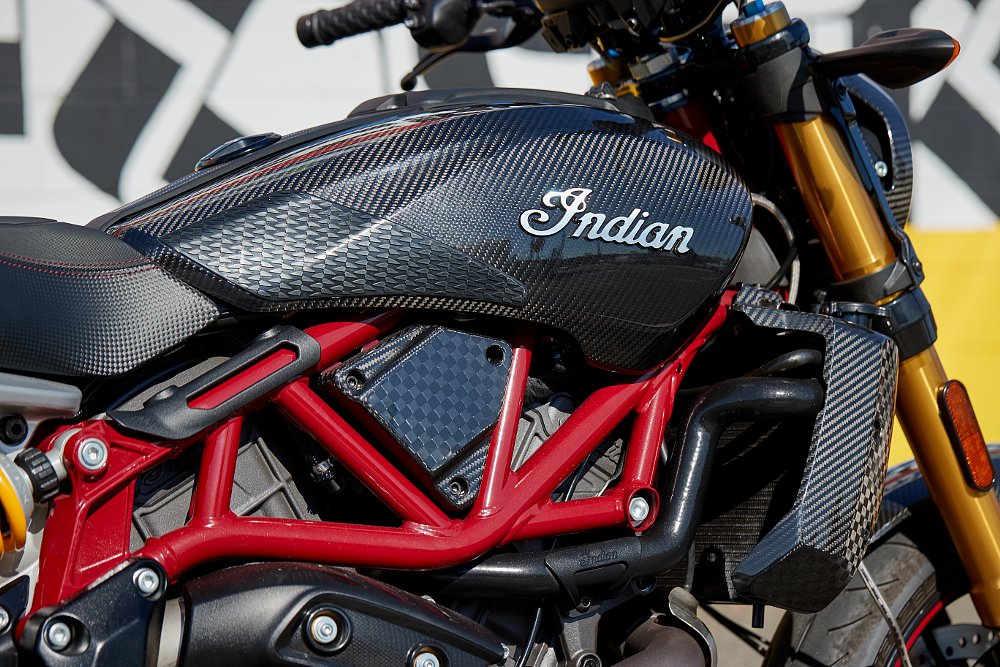
In all scenarios, the fuel range is a bit of an issue. The FTR only gets 125 miles or so before the fuel light comes on. That’s like… Sportster and electric motorcycle territory. I hoped that Indian would find a way to increase fuel capacity after the first gen had the same issue. Unfortunately, it’s not as simple as sticking a bigger tank on the bike, because what looks like the gas tank is actually the airbox. The fuel sits in a plastic section under the seat. Notice that the filler cap is mounted low and close to the seat, unlike a “real” gas cap that would sit at the very top. The seat will have you stopping for a stretch in about 125 miles, anyway, so this isn’t the biggest deal for a motorcycle that will probably be ridden in short, violent bursts. Using the intuitive cruise control seemed to help with fuel economy a little. Throttle-happy riding had me in the mid 30s, and calmer jaunts cracked into the 40 mpg range.
While you’re at the gas station, get ready to answer questions from looky-loos. “Is that an Indian? Is it fast? Is it made in America? What’s it called? Is it made in America? Is that real carbon fiber? Is it made in America?”
Some of the old-timers who asked about the FTR owned and rode Indians back in the day, and one guy actually raced amateur flat track. It sure made him smile to see the Indian script logo on the bike’s side. Another older rider told me a bunch of crash stories before wishing me a very sincere “Safe travels!” A Super Duke would never earn such respect or admiration on Main Street.
As I rode away from one of those encounters, I thought about the reasons this motorcycle has such a profound effect on bystanders. It’s visually striking, no doubt. Most folks haven’t seen anything like it before. The realization that it’s an Indian always kicks the questions into overdrive, and I think that’s because people immediately envision a kind of comeback story for a brand that’s still fondly remembered, a little mental movie about a return to glory. If Indian’s back and building motorcycles like this, then a piece of Americana persevered in some way. While the real story is a little more complex than that, the reaction is the same wherever you ride. It’s handsome, powerful, and somehow trustworthy in spite of its true character. I wonder what a psychologist would say about that.
For daily riding and highway travel, the FTR works better than you might think. The bike’s heft keeps the ride solid and planted. Even though I know that little headlight cowl isn’t doing much to get the wind off my chest, the FTR is more limited by its fuel range than rider fatigue from buffeting. The riding position is upright, “commanding” in Indian’s words, with enough forward lean that I could attack tighter roads with confidence. The R Carbon gets knee grip pads that drastically improve the rider’s ability to lock onto the tank when needed.
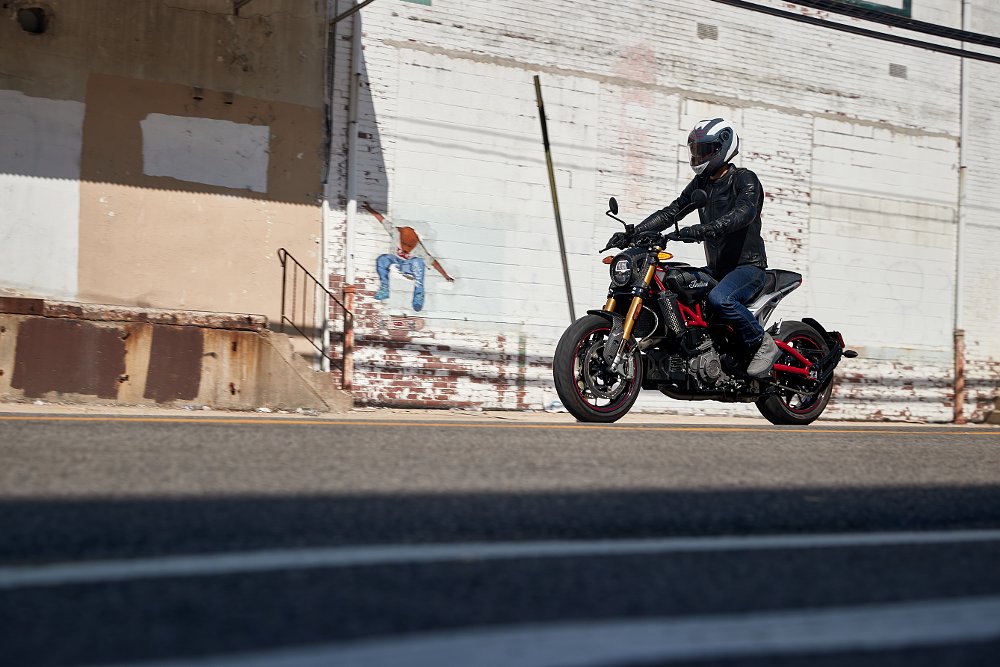
Blasting up and down the gears is a slick experience. No complaints from the old school cable clutch, either. The throttle is where I feel the bike could use some improvement, or maybe an aftermarket tuning solution. The throttle is sensitive enough that a beginner rider could get frustrated in a hurry in both Standard and Sport modes. (There is a Rain mode that cranks up the safety systems and turns down the power.) Around 3,250 rpm, the bike exhibits a surging behavior even with the throttle held at a steady position. I suspect most of that comes from the factory tune, which must have this motorcycle running leaner than a George Foreman grill to get past emissions regulations. It definitely dampens the experience when riding around town at low speeds, although it seems better than the first generation in this regard.
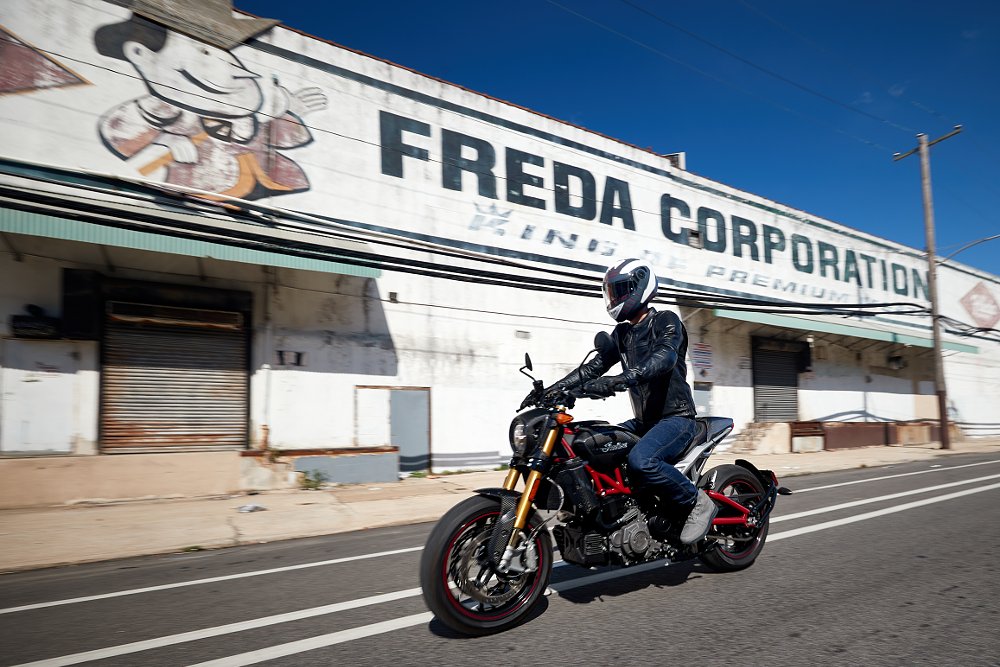
On the fun roads, I found myself riding a gear down from where I’d be on a 750 cc to 1200 cc machine. The power delivery could almost be compared to a two-stroke’s. Keep it on the boil, and let the engine stay in its happy place between 5,000 rpm and 8,000 rpm. Engine braking from the high-comp mill is downright fearsome compared to a four or a triple. This is a feature, not a bug, when charging up a hill. Coming back down requires generous use of the wonderful front Brembos. The adjustable front brake lever has excellent response and feel. Indian’s wide handlebar gives plenty of leverage for muscling this brute around, and that sensation of guiding the bike through bends is one of the FTR’s finest moments. Standard mode quickly became my default choice for the majority of my riding.
There's no getting around it: This is an aggressive motorcycle. It wants to go fast all the time, it's not happy in foul weather, and it sulks when riding at a relaxed pace. Come to think of it, I know some riders who are just like that. They are probably the best customers in the world for Indian's FTR.
Changes I’d like to see
Indian's Ride Command system is uncluttered and intuitive to use, but it doesn't have navigation capabilities for some reason. I don't think that's too much to ask for a motorcycle that will cost nearly $20,000 out the door. While we're at it, an up/down quickshifter would be right at home on this engine. Maybe the worst change of all over the first gen is that ABS is no longer switchable. Then again, the new wheel sizes make it very clear that this motorcycle should stay on the road, and maybe keeping the ABS on isn’t a bad idea. (Those of you who want to get dirty on an FTR can look at the Rally model. Be advised that it isn’t really meant for more than fire roads, since the engine and battery do not have any protection.) A final request is a hinge for the gas cap.
And what about, you know, flat tracking?
Fuhgeddaboudit! For better or worse, the last pretensions of flat tracking left with the old wheelset, and I don’t want to know what a side’s worth of replacement carbon body panels costs. I did take a few off-road excursions on gravel and packed dirt in the interests of a complete review, and it felt like attempting to ride any other sport standard where it shouldn’t go.
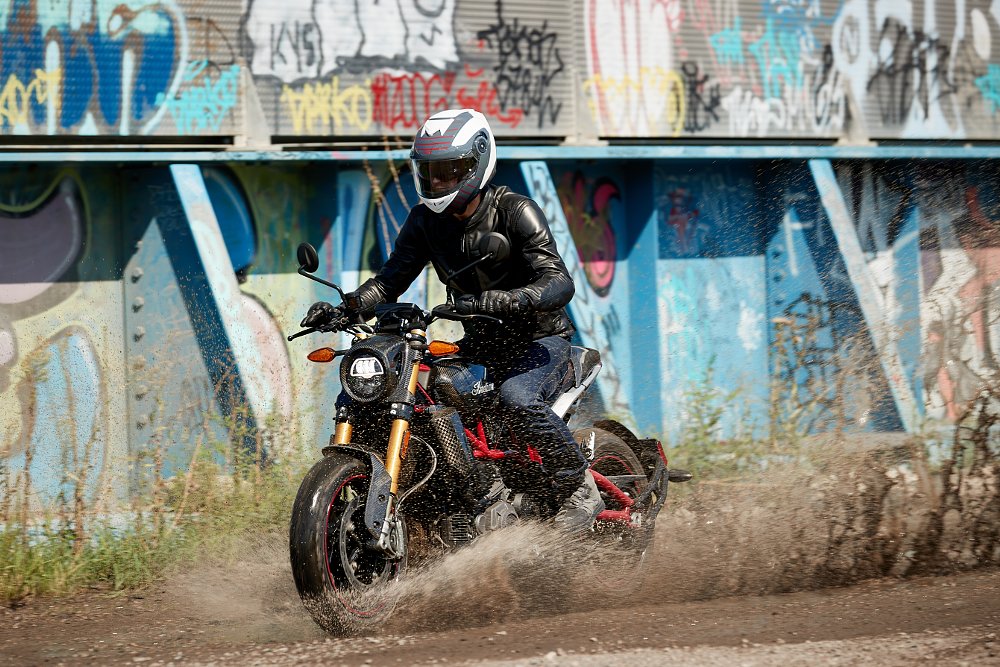
The loss of the ABS toggle function put the kibosh on dirt antics, and that’s a trade I’d happily make for the improved street performance. The FTR threw a lot of dirt and probably looked cool in the process, but cleaning all that dried mud out afterwards was a chore. Let’s just say I wouldn’t have goofed around in the mud and silt with this bike if I personally owned it.
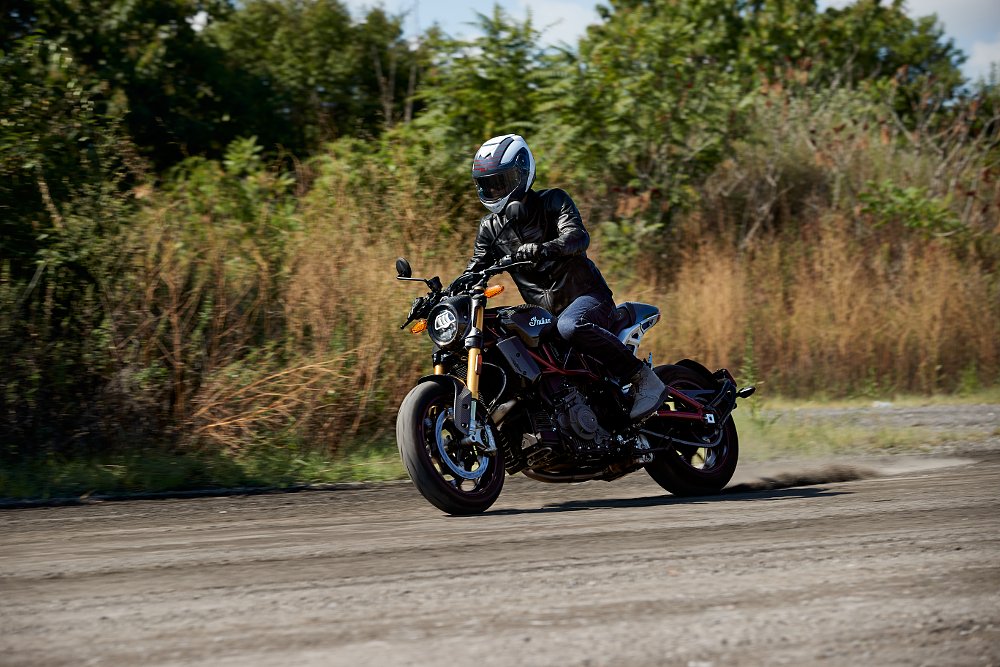
While we’re talking about personal ownership, I’m not the target customer for this motorcycle. My tastes are too practical, and I know I could strafe my favorite roads with just as much speed on something lighter and less concerned with style. The R Carbon is a big, bad sprinter for the power-hungry. And if you’re shopping for something built in the United States, there is no finer mainstream option in the sport naked category. There’s a sense of pride that comes with fit, finish, and sheer acceleration like this, not to mention all the attention.
A third generation of FTRs with better fuel range, improved low-speed mapping, and some weight reduction would put the FTR where it needs to be. A smaller, cheaper version with, say, 750 cc to 900 cc would also have huge potential. (No, I’m not talking about the race-only FTR750.) Consider the fact that Indian’s lightest models all make 100 horsepower or more, and even though some of the big cruisers dip down into the 70-horsepower range, they are heavy beasts weighing anywhere from 670 pounds to nearly half a ton. Indian should roll a smaller FTR before Harley-Davidson gets around to building its streetfighter.
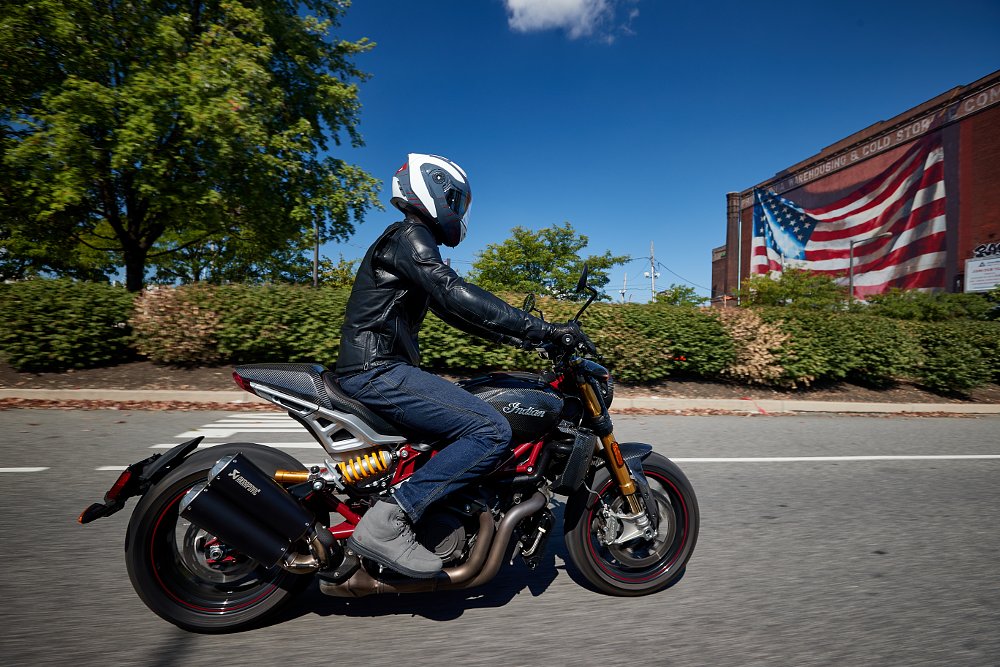
Pricing and competition
The FTR is available in five variants: the base FTR, the FTR Rally, the FTR S, the FTR Championship Edition, and the FTR R Carbon. At $16,999, the R Carbon sits in a hotly contested segment, even though the FTR itself could be called a class of its own. That doesn't mean it is immune to cross-shopping, especially when there are so many compelling high-performance motorcycles in the $16,000-to-$20,000 price range.
Ducati is an obvious comparison here with its sport standard Monster line. Triumph’s new Speed Triples, the RS and the RR, would be worthy opponents. Harley-Davidson’s Sportster S has the power and the aesthetic presence, but it makes even more compromises for style than the FTR with a much harsher ride. Honda’s CB1000R could be roped into this comparo, I suppose. Indian is simply the only manufacturer offering a motorcycle that ticks certain boxes. It’s always a pleasure to test something that’s genuinely unique.
I still don’t know who this motorcycle is for, exactly. If you’re coming to the FTR from a cruiser background, it’ll feel like a rocket. If you’re coming from the sport bike world, it’ll feel heavy, raw, and kinda classy. And if you’re coming from a previous FTR model, the new changes will either feel like blasphemy or revelation. So here are the big questions: Has flat-track racing served its purpose for Indian’s street sales? Should Indian keep changing the FTR to attract younger customers with appetites for premium, made-in-USA performance? The bike I tested says yes to both.
Polaris/Indian chose flat track as the avenue through which it would build brand recognition and credibility, and that foothold helped build a credible reboot of the brand. The second generation of the FTR suggests Indian is focusing more on making real-world motorcycles than making associations with racing success, and in a world where “win on Sunday, sell on Monday” no longer matters, this feels like a step in the right direction.
| 2022 Indian FTR, FTR S, FTR R Carbon | 2022 Indian FTR Rally | |
|---|---|---|
| Price (MSRP) |
FTR: $12,999 U.S., $15,999 Canada |
$13,999 U.S., $16,999 Canada |
| Engine | 1,203 cc, liquid-cooled, eight-valve, 60-degree V-twin | |
|
Transmission, final drive |
Six-speed, chain | |
| Claimed horsepower | 120 @ 7,750 rpm | |
| Claimed torque | 87 foot-pounds @ 6,000 rpm | |
| Frame | Steel trellis | |
| Front suspension |
FTR and FTR S: Sachs 43 mm inverted fork, fully adjustable; 4.7 inches of travel |
43 mm inverted fork; 5.9 inches of travel |
| Rear suspension |
FTR and FTR S: Sachs fully adjustable shock; 4.7 inches of travel FTR R Carbon: Öhlins fully adjustable shock; 4.7 inches of travel |
Monoshock; 5.9 inches of travel |
| Front brake | Dual Brembo four-piston calipers, 320 mm discs, ABS | |
| Rear brake | Brembo two-piston caliper, 260 mm disc, ABS | |
| Rake, trail | 25.3 degrees, 3.9 inches |
26.3 degrees, 5.1 inches |
| Wheelbase | 60.0 inches | |
| Seat height | 32.2 inches (unladen) | 33.1 inches (unladen) |
| Fuel capacity | 3.4 gallons | |
| Tires | Metzeler Sportec 120/70/R17 front, 180/55/R17 rear |
Pirelli Scorpion Rally STR, 120/70/R19 front, 150/70/R18 rear |
| Claimed wet weight |
FTR and FTR S: 514 pounds FTR R Carbon: 513 pounds |
529 pounds |
| Available | Now | |
| Warranty | 24 months | |
| More info | IndianMotorcycle.com | |














